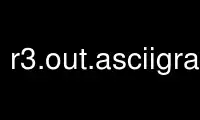
This is the command r3.out.asciigrass that can be run in the OnWorks free hosting provider using one of our multiple free online workstations such as Ubuntu Online, Fedora Online, Windows online emulator or MAC OS online emulator
PROGRAM:
NAME
r3.out.ascii - Converts a 3D raster map layer into a ASCII text file.
KEYWORDS
raster3d, export, voxel, conversion, ASCII
SYNOPSIS
r3.out.ascii
r3.out.ascii --help
r3.out.ascii [-hrdcm] input=string [output=name] [precision=integer]
[null_value=string] [--overwrite] [--help] [--verbose] [--quiet] [--ui]
Flags:
-h
Suppress printing of header information
-r
Switch the row order in output from north->south to south->north
-d
Switch the depth order in output from bottom->top to top->bottom
-c
Print grass6 compatible format. Flags -d and -r are ignored.
-m
Use 3D raster mask (if exists) with input map
--overwrite
Allow output files to overwrite existing files
--help
Print usage summary
--verbose
Verbose module output
--quiet
Quiet module output
--ui
Force launching GUI dialog
Parameters:
input=string [required]
3D raster map to be converted to ASCII
output=name
Name for ASCII output file
precision=integer
Number of decimal places for floats
Options: 0-20
Default: 8
null_value=string
String representing NULL value
Default: *
DESCRIPTION
r3.out.ascii exports a 3D raster map in ASCII format. The input parameter is a valid 3D
raster map in the current mapset search path. The output parameter is the name of an ASCII
file which will be written in the current working directory.
If output is not specified then standard output (stdout) is used. The -h flag may be used
to suppress header information. The module is sensitive to region settings (set with
g.region).
The -c flag will create GRASS 6 r3.in.ascii compatible output.
NOTES
The default format of the exported ASCII file is equivalent to that required by
r3.in.ascii. In particular, files output by r3.out.ascii with header information may be
converted back to 3D raster maps with r3.in.ascii.
The format of the ASCII file is:
version: "grass7"
order: "nsbt" or "nstb" or "snbt" or "sntb"
north: floating point
south: floating point
east: floating point
west: floating point
top: floating point
bottom: floating point
rows: integer
cols: integer
levels: integer
The version and order options have been introduced in GRASS 7 in June 2011. The order
option describes the order of rows and depths in the output. It is possible to create
output of different row order using the -r flag and output of different depths order using
the -d flag. The default order is:
west -> east for columns
north -> south for rows
bottom -> top for depths
This header is followed by the cell values in floating point format organized in rows with
constant col and level coordinate. The rows are organized by constant level coordinate.
Individual cell values are separated by space or CR. Cell values are exported as a series
of horizontal slices in row-major order. The data starts with the upper left corner (NW)
at the bottom of the data set. The values at the following coordinates are exported:
(x, y + rows, z) (x + 1, y + rows, z) ... (x + cols, y + rows, z)
(x, y + rows, z) (x + 1, y + rows - 1, z) ... (x + cols, y + rows - 1, z)
. . .
. . .
. . .
(x, y, z + depths) (x + 1, y, z + depths) ... (x + cols, y, z + depths)
This order is compatible with the r.in.ascii row -> column ordering.
Supported orders are:
· nsbt: north -> south and bottom -> top ordering which is the default (no flags)
· snbt: south -> north and bottom -> top ordering using -r flag
· nstb: north -> south and top -> bottom ordering using -d flag
· sntb: south -> north and top -> bottom ordering using -rd flag
The internal storage scheme of 3D raster maps is visualized in the following picture:
The coordinate system and tile layout of a voxel map in
GRASS
One level maps can be imported with r.in.ascii (2D raster) using the default nsbt order
and removing the header lines "version", "order", "top", "bottom" and "levels".
Example
We define a small region with 4 columns, 3 rows and 2 depths (4x3x2) and export it using
different ordering definitions:
g.region res3=1 t=2 b=0 w=0 e=4 s=0 n=3
r3.mapcalc "simple_example = row() + col() + depth()"
Default order:
r3.out.ascii input=simple_example dp=0
version: grass7
order: nsbt
north: 3.000000
south: 0.000000
east: 4.000000
west: 0.000000
top: 2.000000
bottom: 0.000000
rows: 3
cols: 4
levels: 2
3 4 5 6
4 5 6 7
5 6 7 8
4 5 6 7
5 6 7 8
6 7 8 9
Inverse row order (-r)
r3.out.ascii input=simple_example dp=0 -r
version: grass7
order: snbt
north: 3.000000
south: 0.000000
east: 4.000000
west: 0.000000
top: 2.000000
bottom: 0.000000
rows: 3
cols: 4
levels: 2
5 6 7 8
4 5 6 7
3 4 5 6
6 7 8 9
5 6 7 8
4 5 6 7
Inverse depth order (-d)
r3.out.ascii input=simple_example dp=0 -d
version: grass7
order: nstb
north: 3.000000
south: 0.000000
east: 4.000000
west: 0.000000
top: 2.000000
bottom: 0.000000
rows: 3
cols: 4
levels: 2
4 5 6 7
5 6 7 8
6 7 8 9
3 4 5 6
4 5 6 7
5 6 7 8
Inverse row and depth order (-rd)
r3.out.ascii input=simple_example dp=0 -rd
version: grass7
order: sntb
north: 3.000000
south: 0.000000
east: 4.000000
west: 0.000000
top: 2.000000
bottom: 0.000000
rows: 3
cols: 4
levels: 2
6 7 8 9
5 6 7 8
4 5 6 7
5 6 7 8
4 5 6 7
3 4 5 6
Use r3.out.asciigrass online using onworks.net services
